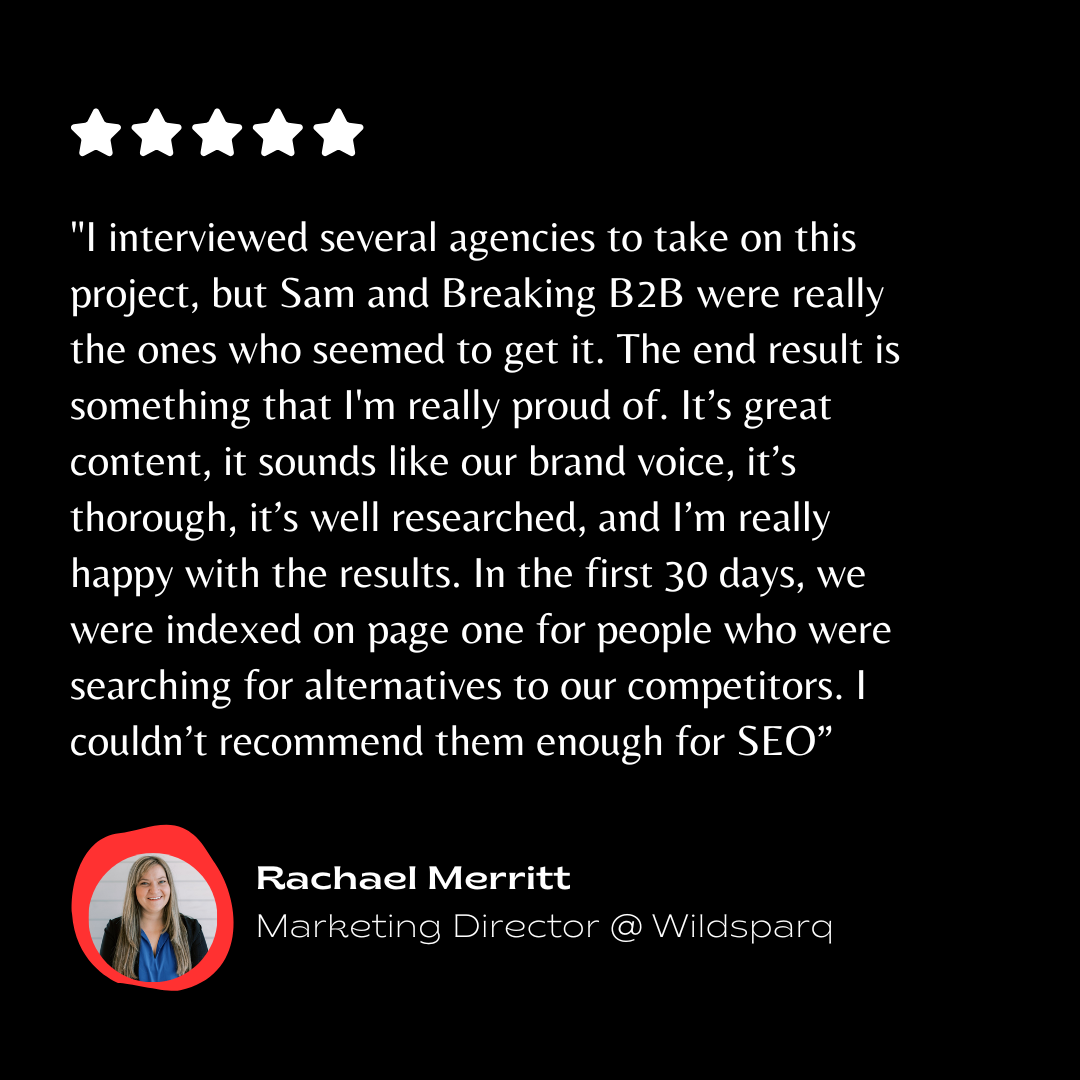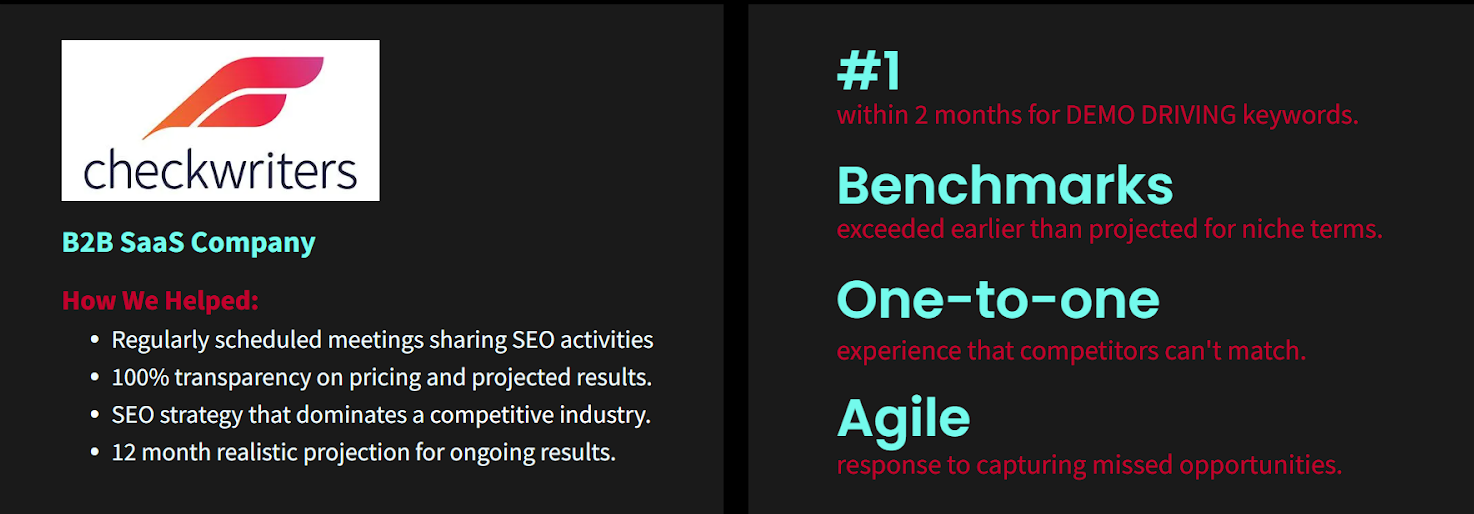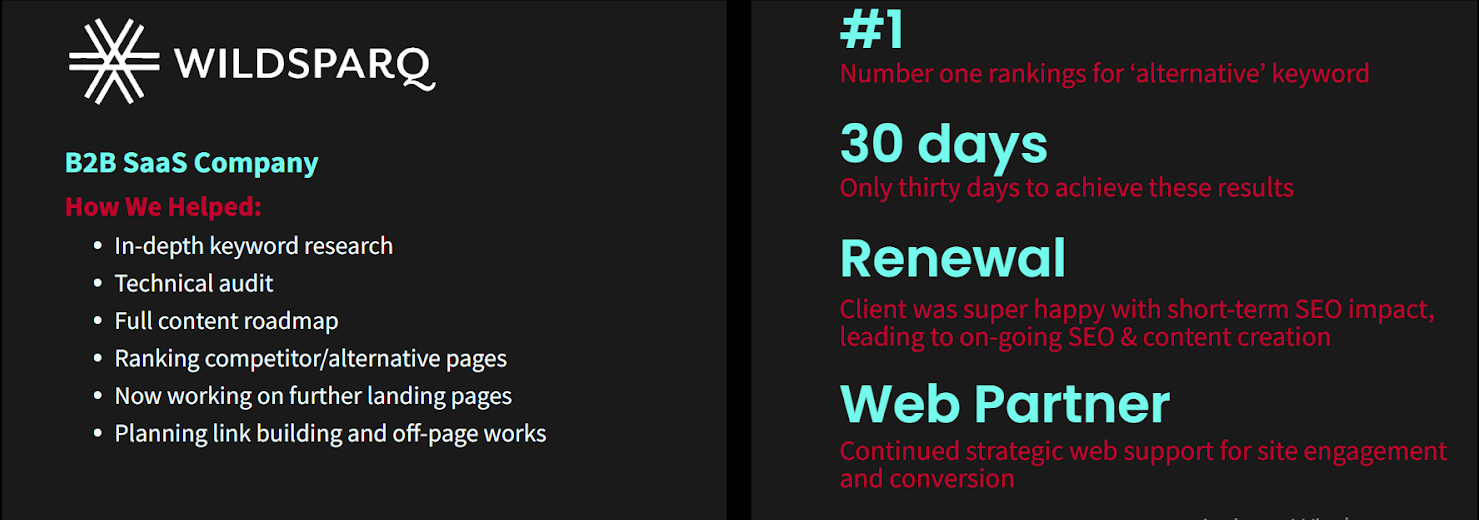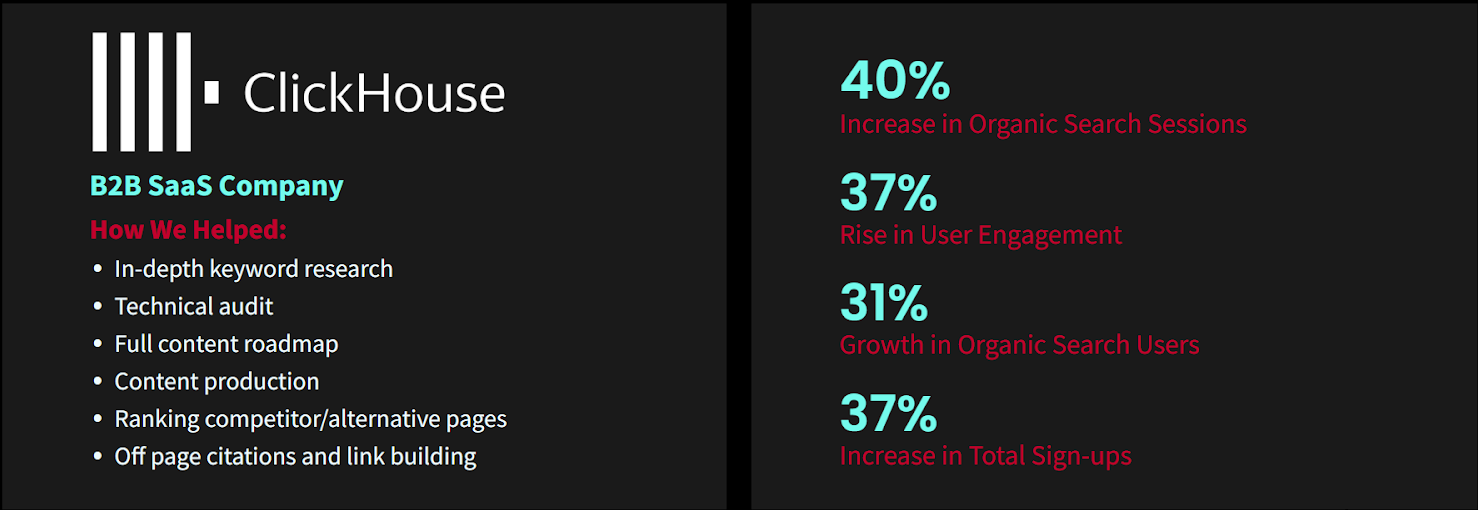Table of Contents
Ready To Grow Organic Pipeline & Revenue?
See if we can scale your organic pipeline from SEO as quick as 90 days.
Quick Summary
Struggling to Find The Right Keywords to Rank For?
If you're tired of seeing competitors above you on Google every time dream clients search for your solution, you're not alone. Most B2B companies we’ve worked with have watched potential customers discover their competitors first.
The reason is simple. Your competitors understand something you don't. They know which keywords drive qualified leads, not just traffic. Therefore, they target buyer intent and not search volume.
In this
Breaking B2B guide, we’ll show you exactly how they do it. You'll learn the keyword research methods that consistently outrank competition and capture high-intent buyers at every stage of the sales funnel.
Why Listen to Us?
At Breaking B2B, we’ve scaled organic visibility for many
B2B SaaS and tech companies. Our proven keyword research methodology has generated millions in pipeline value through strategic content targeting. We understand the nuances of B2B buyer behavior and search patterns that drive real business results. For more practical insights on B2B keyword research, visit our
blog.

What Is B2B Keyword Research?
B2B keyword research is about understanding what your potential buyers are really looking for, not just in terms of search volume, but in the context of their job, their goals, and the problems they’re trying to solve. Unlike B2C, where someone might Google and buy within minutes, B2B buyers often research over days or weeks, loop in other stakeholders, and ask far more specific, high-intent questions.
As a marketer, your job isn’t just to rank. It’s to figure out which search terms actually move someone closer to a sales conversation. That means thinking beyond traffic. The right B2B keywords tie directly to revenue because they match what decision-makers are typing in when they’re looking to act.
Why Is B2B Keyword Research Important?
If you want to grow sustainably through organic search, B2B keyword research is where it starts. Here’s why it matters:
- You attract qualified buyers, not just visitors: B2B buyers don’t search like everyday consumers. They’re using niche terms, industry jargon, and questions tied to real business problems. Smart keyword research helps you show up when those decision-makers are actively looking for what you offer.
- It aligns SEO with actual revenue: Not all traffic is created equal. The right keywords bring in leads that match your ICP, understand your value, and can afford your product or service. You’re not just chasing clicks, you’re building a sales pipeline.
- It gives you a competitive edge: Every content gap is an opportunity. With the right research, you can find keywords your competitors missed and win visibility where they aren’t even looking.
- It supports long-term growth: By consistently targeting the right topics, you build topical authority. That means better rankings, stronger trust signals, and a durable presence in your niche.
- It enables your sales team: When your content answers the exact questions your buyers are Googling, it becomes a powerful tool for sales. It builds credibility and helps move leads one step closer to closing.
How to Execute Valuable B2B Keyword Research
1. Define Your Ideal Customer Profile and Buyer Personas
Before diving into keyword tools, you need to establish who you're targeting. B2B keyword research starts with understanding your ideal customer's role, challenges, and search behavior. You can do this by doing the following:
- Create detailed buyer personas. This includes job titles, responsibilities, pain points, and decision-making authority.
- Map each persona's search journey from problem awareness to vendor evaluation. Technical buyers search for implementation details and product comparisons. Economic buyers focus on ROI and business impact. User buyers prioritize ease of use and functionality.
- Document the specific terminology each persona uses. A CTO is likely to search for "enterprise security architecture" while a marketing manager may use words like "lead generation tools." This vocabulary becomes your keyword foundation.
- Use tools like Ahrefs, SEMrush, or Moz to analyze competitor content targeting your personas. Review their blog posts, landing pages, and resource content to understand keyword themes and search intent patterns.
Feel free to watch Sam's deep dive on why keyword research is key to SEO success in Why Keyword Research is Key for SEO Success for more walkthrough strategies.
You can also validate persona assumptions, search behavior, and language preferences through customer interviews and sales team feedback.
2. Analyze Competitor Keyword Strategies
Competitor analysis reveals market opportunities and content gaps. To achieve this, you can follow the steps below:
- Use SEMrush or Ahrefs to analyze 3-5 direct competitors' organic keyword performance. Then, focus on keywords driving their most valuable traffic and conversions.
- Identify competitor content clusters and topical authority areas. Look for patterns in their keyword targeting, content formats, and user intent coverage. Export their top-performing keywords and analyze search volume, difficulty, and business relevance.
- Use tools like SpyFu or SimilarWeb to uncover competitor paid search campaigns. Their PPC keywords often indicate high-converting search terms worth targeting organically. Pay attention to ad copy language and landing page messaging.
- Analyze competitor content gaps using keyword gap analysis tools. Find keywords they're missing or underserving. These represent immediate opportunities for content creation and organic growth.
- Review competitor SERP features and rich snippets. Identify opportunities to capture featured snippets, People Also Ask sections, and other valuable SERP real estate. Document their content formats and optimization strategies.
- Create a competitive keyword matrix comparing your current rankings against competitors. Prioritize keywords where competitors are weak or where you can create superior content. This analysis guides your content calendar and resource allocation.
At
Breaking B2B, we’ve helped companies like Checkwriters outrank their competitors within just two months of working together. With regular strategy calls, full transparency, and an agile SEO approach, we exceeded niche benchmarks ahead of schedule. Our one-to-one support gave them an edge their competitors couldn’t match.

For more insights, watch Sam Dunning's deep dive on how to outrank giant competitors with SEO.
3. Build Your Seed Keyword List
Do the following to assemble your seed keyword list:
- Start by identifying broad industry terms and the core pain points your prospects face. Think through your product categories, common use cases, and competitor alternatives. Be sure to include problem-focused keywords that reflect how early-stage buyers search for solutions.
- Next, turn to Google’s Autocomplete and the “People Also Ask” sections to uncover related search terms. These insights come straight from real user behavior and often surface long-tail keyword opportunities and variations you might miss otherwise.
- Dig into customer support tickets and sales conversations to find keyword ideas based on real-world language. Prospects often describe their needs differently than marketers expect. Sales and support teams regularly hear questions and objections that can be turned into high-value keyword opportunities.
- Pay attention to social media channels and online communities using listening tools. LinkedIn posts, Twitter threads, Reddit, and industry-specific forums often highlight trending topics and language your audience is using right now. It’s perfect for surfacing new search terms and timely content angles.
- Then, use keyword tools like Ubersuggest, Answer the Public, or Keywords Everywhere to grow your keyword list. These tools can help you uncover related terms, popular questions, and long-tail variations tied to your seed keywords.
- Finally, organize your keyword list by buyer journey stage (such as awareness, consideration, and decision) and by business impact. This structure not only sharpens your content strategy but also supports smarter internal linking and campaign planning.
4. Analyze Search Intent and Buyer Journey Mapping
Understanding search intent is essential for successful B2B keyword targeting. You can begin by doing the following:
- Start by categorizing keywords into informational, navigational, commercial, or transactional intent. Each type reflects a different stage of the buyer journey and requires a specific content approach.
- Next, map keywords to journey stages: awareness-stage terms focus on education and problem identification; consideration-stage keywords reflect solution research and comparisons; decision-stage terms indicate purchase readiness and vendor evaluation.
- Use SERP analysis to see how Google interprets intent. Review the top-ranking pages, whether they’re blogs, product pages, or comparison guides, to align your content format with what performs best.
- Explore related keywords and semantic clusters. Google rewards topic depth, so use tools like Clearscope or MarketMuse to uncover related terms and ensure comprehensive coverage.
- Check keyword difficulty to balance quick wins with long-term goals. High-difficulty keywords need stronger content and authority, while low-competition terms offer faster results.
- Finally, create intent-driven content templates. Educational content works best for awareness-stage keywords, while detailed comparisons are ideal for high-intent searches near the point of purchase.
At Breaking B2B, we specialize in creating content that meets SaaS buyers at the bottom of the funnel, where your pipeline is made. This includes building out competitor comparison pages, use-case breakdowns, and feature-specific landing pages that tie directly to qualified leads.
We did this for Wildsparq, an online leadership B2B SaaS tool, which led to a number 1 ranking across keywords in 30 days.

5. Leverage Advanced Keyword Research Tools
Professional keyword research requires sophisticated tools beyond Google Keyword Planner. Below are the list of tools you can explore:
- Ahrefs provides comprehensive competitor analysis, keyword difficulty scoring, and content gap identification. Their Keywords Explorer reveals search volume trends and SERP feature opportunities.
- SEMrush excels at competitive intelligence and PPC keyword research. Use their Keyword Magic Tool to discover long-tail variations and question-based keywords. Their Topic Research tool identifies content clusters and related subtopics.
- Moz Keyword Explorer offers unique metrics like Priority Score and Organic CTR data. Their SERP analysis features help identify content optimization opportunities and featured snippet potential.
- Specialized B2B tools like Clearscope and MarketMuse provide semantic keyword analysis and content optimization recommendations. These tools identify related terms and content depth requirements for comprehensive topic coverage.
- Use Answer the Public for question-based keyword discovery. B2B buyers often search with specific questions about implementation, pricing, and feature comparisons. These keywords often have high conversion potential.
- Google Search Console provides invaluable first-party data about your current keyword performance. Analyze impression data, click-through rates, and position changes to identify optimization opportunities and content gaps.
6. Prioritize Keywords for Maximum Business Impact
Not all keywords deserve equal attention. So, you need to develop a scoring system that balances search volume, keyword difficulty, and business relevance. High-intent keywords with moderate competition often provide the best ROI. Here are some proven steps to achieve this:
- Focus on keywords that drive revenue and not just traffic. Score each keyword from 1 to 10 for search volume, keyword difficulty, and business relevance. Then, double the business relevance score to give it more weight. This weighted approach helps ensure your content targets high-impact, high-intent searches.
- Focus on long-tail keywords that show clear buyer intent. For example, “best CRM for small business” is more likely to convert than a broad term like “CRM software,” since it reflects a prospect closer to a purchasing decision.
- Factor in seasonal trends and business cycles. B2B buying decisions often align with budgeting periods or fiscal year planning. Tools like Google Trends can help you identify the best timing for specific keyword campaigns.
- Aim to balance quick wins with long-term growth. Target lower-difficulty keywords to gain visibility fast, while also building more in-depth content around competitive, high-value terms.
- Finally, group your keywords into clusters around core business topics. This strategy boosts topical authority and improves rankings by reinforcing internal links and semantic relevance across your content.
Best Practices for B2B Keyword Research
Focus on Buyer Intent Over Search Volume
It’s easy to get distracted by keywords with big numbers. But in B2B, the gold lies in intent. A keyword with 100 monthly searches can be far more valuable than one with 5,000 if it’s tied to a high-stakes business problem. Look for terms that signal action, budget, or pain points, those are the searches that turn into sales calls.
Think in Clusters, Not Isolated Keywords
B2B buyers rarely convert after reading a single blog post. They explore, compare, and dig deeper. That’s why topic clusters work. Anchor your strategy with a strong pillar page, then build supporting content that covers long-tail questions, comparisons, and use cases. You’ll build topical authority and make it easier for both buyers and search engines to connect the dots.
Use Your Own Data to Guide You
Your best keyword ideas might already be sitting in sales calls, support tickets, or demo feedback. Listen to how customers describe their problems. Use that exact language in your research. Tools are helpful, but they often miss the nuance of real buyer conversations. First-party insights keep your content grounded in what your audience actually cares about.
Keep Tabs On Your Competitors, But Don’t Copy
Markets shift fast. The keywords your competitors go after can reveal new trends or strategic shifts. Use alerts and tracking tools to monitor how their content and rankings evolve. This isn’t about playing catch-up, it’s about spotting gaps and moving where they’re not.
Match Your Keywords to Funnel Stages
Not every search is a buying signal. Someone looking for “what is SOC 2 compliance” is in a different headspace than someone Googling “SOC 2 compliance software pricing.” Map your keywords to awareness, consideration, and decision stages, and build content that meets buyers where they are. This helps
B2B SEO support the full sales journey and not just the top of the funnel.
Transform Your B2B Growth with Strategic Keyword Research
B2B keyword research isn't just about finding search terms. It's about understanding buyer behavior and creating content that drives qualified leads. By focusing on buyer intent, competitor analysis, and systematic prioritization, you can build an organic growth engine that consistently delivers revenue results.

Breaking B2B specializes in revenue-focused keyword research for B2B SaaS and tech companies. Our proven methodology has helped 50+ companies scale organic visibility and generate millions in pipeline value through strategic content targeting.
Ready to drive quality leads using strategic keyword research? Book a call with us today!







